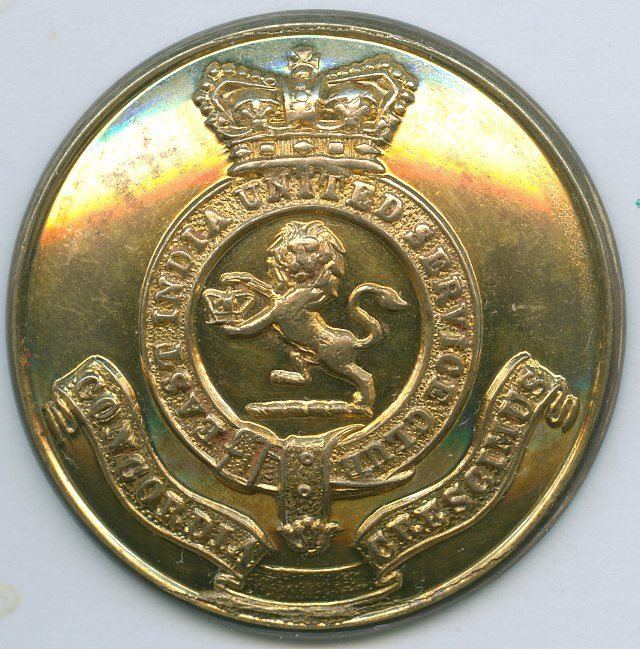Formation 1849 (1849) Founded 1849 | Website www.eastindiaclub.com Phone +44 20 7930 1000 | |
 | ||
Motto Concordia Crescimus (Latin) Similar Oxford and Cambridge Club, The Lansdow Club, The In & Out Naval & Military, The Athenaeum, The Travellers Club | ||
The East India, Devonshire, Sports and Public Schools' Club, usually known as the East India Club, is a gentlemen's club founded in 1849 and situated at 16 St. James's Square in London. Membership of the club is strictly by nomination and election only.
Contents
History
Founded in the middle of the 19th century, the club's original members, as set out in the Rule Book of 1851, were-
But within the first two decades of the club's foundation, the East India Company started to lose its Indian possessions and was wound up (dissolved) entirely in 1874. As a result, the club could no longer look to the East India Company as its main source of members.
Since then, the club has amalgamated with the Sports Club (1938), the Public Schools Club (1972) and the Devonshire (1976), all of which ran into the twin problems of keeping up membership numbers and making ends meet, especially with the escalating costs of maintenance for historic buildings. With the disappearance of the East India Company, the public school influence has become an important one.
The club's facilities include a dining room and a luncheon room in addition to the American Bar (named in gratitude to the American officers who stayed at the club during the Second World War and provided funds to refurbish the bar after the war), the Canadian Room (named in gratitude to the Canadian officers who stayed at the club during the Second World War and afterwards provided the timber for the room when it was still in short supply), the Drawing Room, the Smoking Room (although smoking within the club is no longer permitted), the library (that includes antiquarian and contemporary books), the Card Room, the Rugby Room (where the International Rugby Board met until its move to Dublin), the New York Room, the Clive Room and a gymnasium, a billiard room and 67 bedrooms (including the St. James's Suite). The East India Club is a popular venue for private events and offers conference facilities.
The East India Club has reciprocity with over 100 clubs throughout the world. Members can use the facilities of overseas reciprocal clubs with a card or letter of introduction issued by the East India Club.
Club house
The East India Club club house is situated on the west side of St. James's Square, London SW1.
The first occupant of the house was Thomas Jermyn, 2nd Baron Jermyn (?1670-1676). He passed the house on to Robert Villiers, 3rd Viscount Purbeck, who occupied the house for two years (1676–1678). After Viscount Purbeck, a Swedish Ambassador occupied the house, followed by two successive Earls of Suffolk and the Earl of Romney. The house was then taken over by Sir John Germain, 1st Baronet, the lover and, later, husband of Mary Howard, Duchess of Norfolk. When Sir John died in 1719, he left the house to his second wife, Lady Elizabeth Berkeley, 2nd daughter of the 2nd Earl of Berkeley. She was to occupy the house for no less than 50 years. When Lady Elizabeth died, the house went to George Germain, 1st Viscount Sackville. It then became the home of Admiral Vere Beauclerk, 1st Baron Vere and then of his son, Aubrey Beauclerk, 5th Duke of St Albans.
In 1785, George Anson bought No. 16. When he died in 1789, the house was passed on to his son, Thomas Anson, 1st Viscount Anson. In 1804, Viscount Anson sold the house to Edmund Boehm, a successful merchant. Mr and Mrs Boehm were very active socially and hosted many dinner parties. On June 21, 1815, the Prince Regent (later George IV) was the principal guest at the dinner party. He heard the news of the victory at Waterloo at the house, where Major Henry Percy, aide-de-camp to the Duke of Wellington, presented the Prince Regent with four captured French eagles and Wellington’s victory despatch.
When Edmund Boehm was declared bankrupt, Robert Vyner became the owner of No. 16. In 1825, Mr Vyner sold the house to the Marquess of Clanricarde. During Lord Clanricarde's tenancy, he let the house for a time to the Marquess Wellesley. In 1849, the East India Club Committee signed a lease with Lord Clanricarde. The club bought the house from Lord Clanricarde in 1863.
Patrons of the Club
Notable members
This is a small selection of the notable people affiliated with the club or its constituent clubs:
In fiction
J. K. Stanford, creator of George Hysteron-Proteron, wrote in 1964 that "George... owed his origin to a face in the East India Club... On one occasion at breakfast he sent for the waiter and said, in my hearing, 'Didn't I order mutton cutlets with blood? There's no blood in these! Take them away!' "
